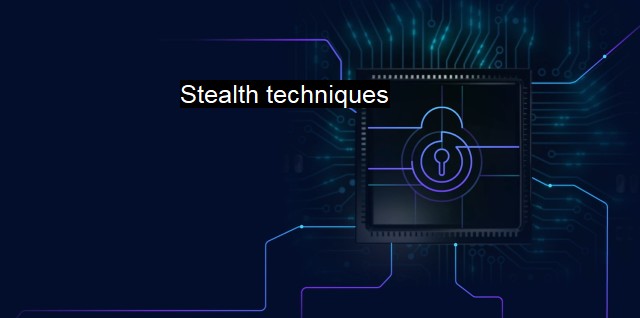What are Stealth techniques?
Unseen and Unbeatable: Exploring Stealth Techniques in Cybersecurity and Antivirus for Enhanced Protection
Stealth techniques are a common feature of the digital combat landscape, prominent among both the supposed "good guys" and "bad guys". Often spoken of this methodology mirrors real-world evasion tactics by using a variety of tools and routes to avoid detection. Despite the average personal computer user imagining viruses and malware in their most troublesome yet identifiable forms, such as pop-ups, stranded files, or noticeable slowdowns, these infractions only scratch the surface of stealth technology's potential.A significant amount of stealth technology is aimed explicitly at proactively counteracting the attempts of cybersecurity antivirus software to detect and eliminate malicious entities. The essence of the strategy lies in operating unobtruously. From operating system vulnerabilities to powered-down software sensible to single instruction alterations, the range of stealth technology deployments brings to bear several distinct mechanisms.
One stealth technique vastly popular among cyber criminals is the rootkit. A rootkit is used to distantly control a computer system without detection, providing cybercriminals with access to personal and confidential information in most cases. These are particularly concerning to IT professionals since antivirus detection doesn't always pick them despite their frequency and potential to do harm. Intricate rootkits can even imitate the visual outputs of certain diagnostic tools to slide under the radar of inbuilt system scanners.
In some cases, stealth methodology is less complex. Fileless malware is a broad class of stealth-based threats that forgo the need for downloaded components by infiltrating the computer's memory directly. By avoiding the hard drive, these threats sidestep the standard route of discouragement for antivirus scans and eradicate a significant line of defense against malware. They typically exploit either user-downloaded files or system vulnerabilities, abusing otherwise innocent processes to carry out malicious intent.
Another strategy employed by malicious entities is the use of encryption and obfuscation tactics. By disguising their own code, the infectious segments are masked from the common virus definitions used by most antivirus programs, making the viral code appear utterly alien in comparison to registered malicious software. This technique allows malware and viruses to vest in systems without the user's knowledge, wreaking havoc with sensitive data and critical functions.
Though these cyber threats have existed at one time or another in the cyber threat continuum, there are also evolving threats that use IoT devices. In this latter stealth technique, the threat entails manipulating household appliances and gadgets to assist in botnet activities or detects signals and data passively. Cybersecurity has begun refactoring its antivirus programs and approaches, factoring this residence in such seemingly harmless environment into its diagnosis and treatment techniques.
While stealth techniques pose a significant concern for computer users, there are tried-and-true methods that can minimise the risks associated with them. The overarching protection lies in strong cybersecurity measures complemented not just by antivirus software, but also, a robust backup strategy and user literacy about secure internet behavior. Properly securing Wi-Fi networks, avoiding dubious downloads, and monitoring spam links, amongst other protocols, serve as effective deterrents.
Increased user awareness about stealth techniques can act as significant impediments to the widespread chaos sought by cybercriminals. Such pedagogy turns the tables on cyber criminals, exploiting their dependency on user ignorance and limited surveillance to systemize defensive shields and dismantle formidable stealth armour. It's not fool proof, but continued vigilance is the price we have to pay to reduce trailed chaos. ignorance isn't bliss, rather it’s a fine-print invitation to digital adversity.

Stealth techniques FAQs
What are stealth techniques in cybersecurity?
Stealth techniques in cybersecurity refer to the methods used by cybercriminals to hide their malicious activities from detection by anti-virus software and other security measures.What are some common stealth techniques used by cybercriminals?
Some common stealth techniques used by cybercriminals include polymorphism, rootkits, and fileless malware. Polymorphism involves continuously changing the code of malware to evade detection by anti-virus software. Rootkits are malicious programs that hide their presence on a system by modifying the operating system. Fileless malware operates in memory, making it difficult for anti-virus software to detect.How can organizations defend against stealth techniques?
Organizations can defend against stealth techniques by employing multiple layers of security measures, including firewalls, intrusion prevention systems, and anti-virus software. Regular security updates and patches are also essential in guarding against known vulnerabilities. Conducting regular security audits and testing can help identify any weakness in the system that cybercriminals could exploit.Can sophisticated malware using stealth techniques ever be completely prevented?
While it is difficult to prevent all sophisticated malware using stealth techniques, organizations can reduce the risk by implementing a multi-layered security approach and staying vigilant against new and evolving threats. Furthermore, employee education and awareness can also play a vital role in preventing malware from entering the system in the first place through phishing scams or social engineering tactics.| | A | | | B | | | C | | | D | | | E | | | F | | | G | | | H | | | I | | | J | | | K | | | L | | | M | |
| | N | | | O | | | P | | | Q | | | R | | | S | | | T | | | U | | | V | | | W | | | X | | | Y | | | Z | |
| | 1 | | | 2 | | | 3 | | | 4 | | | 7 | | | 8 | | |||||||